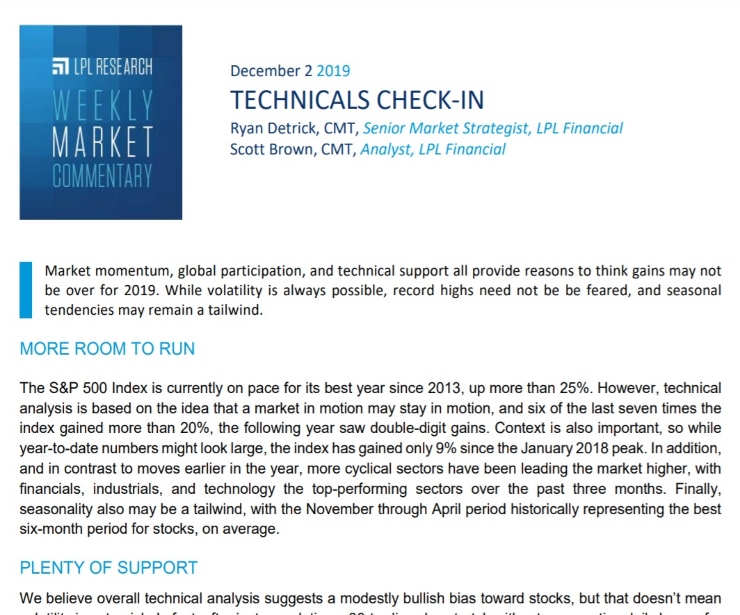Market momentum, global participation, and technical support all provide reasons to think gains may not be over for 2019. While volatility is always possible, record highs need not be be feared, and seasonal tendencies may remain a tailwind.
MORE ROOM TO RUN
The S&P 500 Index is currently on pace for its best year since 2013, up more than 25%. However, technical analysis is based on the idea that a market in motion may stay in motion, and six of the last seven times the index gained more than 20%, the following year saw double-digit gains. Context is also important, so while year-to-date numbers might look large, the index has gained only 9% since the January 2018 peak. In addition, and in contrast to moves earlier in the year, more cyclical sectors have been leading the market higher, with financials, industrials, and technology the top-performing sectors over the past three months. Finally, seasonality also may be a tailwind, with the November through April period historically representing the best six-month period for stocks, on average.
PLENTY OF SUPPORT
We believe overall technical analysis suggests a modestly bullish bias toward stocks, but that doesn’t mean volatility is not a risk. In fact, after just completing a 30-trading-day stretch without consecutive daily losses for the S&P 500, it makes sense that volatility could be poised to pick up. However, on any pullbacks we see several key levels of technical support that may support equities and dampen the magnitude of any fall.

As shown in [FIGURE 1], 3,030 served as market resistance in July and September. A key principle of technical analysis suggests that points that act as resistance may act as support once that level gives way. Support here is strengthened by the 50-day moving average, which is rising and near the same level. The next level of support—2,950—is about 3% below 3,030. This was not only near the 2018 highs (before the fourth quarter correction), but also was resistance in May of this year before the market suffered its deepest pullback year to date. The rising 200-day moving average also strengthens the case that buyers may step in near this level.
SMALL CAPS JOIN THE PARTY
It took nearly 15 months, but the last week of November the Russell 2000 Index broke out to a new 52-week high. Small caps have lagged their larger counterparts for much of this year, and the Russell 2000 is still nearly 7% away from new highs, but this development is a major step in the right direction. Perhaps more importantly, forward returns historically have been impressive when the Russell 2000 has gone more than a year without making new 52-week highs. In those instances, the Russell 2000 has risen 10 of 11 times over the next 12 months, with an average return of 17%.
NOT JUST A U.S. STORY
Canada, India, Brazil, and Switzerland are just a few of the countries whose stock markets have hit all-time record highs within the past month. Last year when the S&P 500 was making record highs, one of the biggest issues was that international markets had been steadily trending lower for much of the year. It seemed like the United States “caught a cold” from the rest of the world and proceeded to drop 19% from peak to trough. That is not the case this year, however, as both the MSCI EAFE and MSCI Emerging Markets indexes are up double-digits year to date. It remains to be seen if these areas can go on a run of sustained outperformance versus the United States, but for now we are encouraged by broad participation in the global bull market.
WEEKLY MARKET PERFORMANCE REPORT
Please see our new Weekly Market Performance report with insights on major asset classes.
Click here to download a PDF of this report.
IMPORTANT DISCLOSURES
The opinions voiced in this material are for general information only and are not intended to provide specific advice or recommendations for any individual. To determine which investment(s) may be appropriate for you, consult your financial advisor prior to investing. All performance referenced is historical and is no guarantee of future results.
The economic forecasts set forth in this material may not develop as predicted.
Investing involves risks including possible loss of principal. No investment strategy or risk management technique can guarantee return or eliminate risk in all market environments.
All indexes are unmanaged and cannot be invested into directly. Unmanaged index returns do not reflect fees, expenses, or sales charges. Index performance is not indicative of the performance of any investment.
All information is believed to be from reliable sources; however LPL Financial makes no representation as to its completeness or accuracy.
This research material has been prepared by LPL Financial LLC.
Securities and advisory services offered through LPL Financial (LPL), a registered investment advisor and broker-dealer (member FINRA/SIPC). Insurance products are offered through LPL or its licensed affiliates. To the extent you are receiving investment advice from a separately registered independent investment advisor, please note that LPL is not an affiliate of and makes no representation with respect to such entity.
If your advisor is located at a bank or credit union, please note that the bank/credit union is not registered as a broker-dealer or investment advisor. Registered representatives of LPL may also be employees of the bank/credit union. These products and services are being offered through LPL or its affiliates, which are separate entities from, and not affiliates of, the bank/credit union. Securities and insurance offered through LPL or its affiliates are:
Not Insured by FDIC/NCUA or Any Other Government Agency | Not Bank/Credit Union Guaranteed | Not Bank/Credit Union Deposits or Obligations | May Lose Value
Tracking # 1-921761 (Exp. 11/20)
